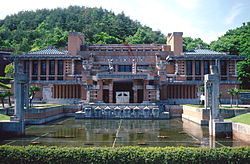Imperial Hotel (company)

The Imperial Hotel (帝国ホテル Teikoku Hoteru) Is a landmark in Tokyo, Japan. founded in the year 1890 at the direction of the imperial palace, Tokyo's legendary Imperial Hotel boasts a history as colorful and dramatic as contemporary Japan itself. From its very first days, The Imperial set the stage for the introduction into Japan of the latest in western technologies, culture and traditions of hospitality.
The original, wooden Victorian-style Imperial, across the avenue from the Emperor's palace on the same site the hotel occupies today, was for many decades the only fully European-style hotel in the capital. It ran in debt for many years offering visiting dignitaries and industry leaders from abroad a reassuring array of familiar facilities and services, including expensive American beds outfitted with fine Irish linens, English sterling silver cutlery, rare French wines, wood-burning fireplaces and the country's first hotel dining room to serve beef and pork, four-legged animals that Buddhist precepts had traditionally forbidden for consumption. By 1923, the hotel had opened a spectacular new building designed by architect Frank Lloyd Wright. On the very day of its grand opening, one of the most devastating earthquakes in recorded history struck Tokyo and Yokohama and razed vast sections of both cities, killing tens of thousands of people, but leaving the new Imperial intact with minimal damage. The hotel opened its doors to foreign embassy staff and foreign correspondents and fed thousands of refugees until relief supplies arrived from the United States.
After the earthquake, the Imperial became the social center in Tokyo for both the international community and travellers from abroad. Arriving at the hotel was surely Fellini-esque in those days, when after disembarking in Yokohama after a month-long steamer voyage, guests were driven through the then-tranquil suburbs of Tokyo and past the turreted Imperial Palace, where cars turned off the road and pulled up under the cedar-framed porte cochere of what at first gance surely seemed uncannily similar to the Mayan ruins at Chichen Itza in the Yucatan. Alighting from his car, the visitor was escorted into a dizzyling collage of stone and space employing the most extravagant features of Mayan and art deco architecture, executed in highly porous green volcanic rock, pierced terra cotta grillwork and yellow brick. The copper rain gutters atop the perimeter of the building drained through elaborately patterned grills that in turn shaped the falling rain water into 50 to 70-foot-high patterns of its own as it fell to the ground below. Massive slabs of cast concrete, in the shape of scarabs, turtles and peacocks, embellished both interior and exterior walls surfaces. Turquoise and beige carpets of American Indian designs, woven in Peking, led through the innumerable geometrical nooks and crannies. Narrow, sinister-looking, low-ceilinged passageways led into airy lobbies and ballrooms whose ceilings were hand-painted in peacock designs and shimmering with gold leaf. Heads of state, royalty, movie stars and tycoons came and went away amazed. By 1968, the Wright Imperial had suffered irreparable damages from floods, earthquakes, wartime bombing and urban pollution, and a team of earthquake specialists declared the structure unsafe and unable to withstand further major tremors. The management glumly had Wright's decaying masterpiece dismantled, and parts of it rebuilt at Meijimura, a sort of Japanese Williamsburg, outside Nagoya, and parts incorporated into its replacement, erected in 1970.
